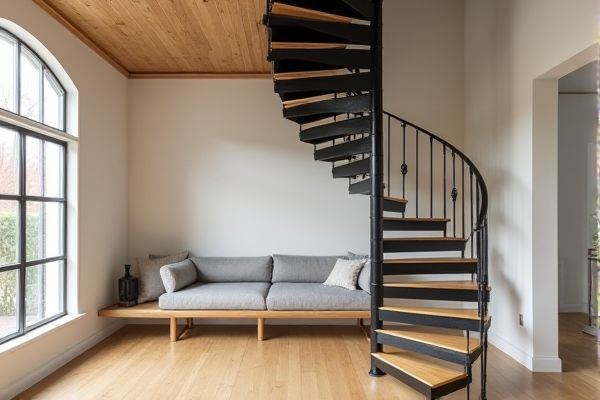
Choosing between a spiral staircase and a straight staircase depends on your space constraints and aesthetic preferences, as spiral staircases save floor area and add a unique architectural element while straight staircases offer ease of use and flexibility in design. Explore the rest of the article to discover which staircase style best suits your home's functionality and style.
Table of Comparison
| Feature | Spiral Staircase | Straight Staircase |
|---|---|---|
| Space Efficiency | Highly compact, ideal for small areas | Requires more linear space |
| Installation Complexity | More complex, requires precise engineering | Simple design, easier installation |
| Cost | Generally higher due to design and materials | Typically lower, straightforward construction |
| Safety | Steeper, narrower steps can be less safe | Wider steps, safer for all ages |
| Accessibility | Less accessible for elderly or disabled | More accessible and user-friendly |
| Aesthetic Appeal | Modern, stylish, architectural focal point | Classic, versatile in interior design |
| Material Options | Commonly metal, wood, or concrete | Wide variety including wood, metal, concrete |
| Maintenance | More demanding due to intricate design | Easy to maintain and clean |
Introduction to Spiral and Straight Staircases
Spiral staircases are compact, space-saving structures with a central pole and steps winding around it, making them ideal for areas with limited room. Straight staircases offer a direct, linear path between floors, providing easier accessibility and simpler construction. When choosing between your options, consider the available space, aesthetic preferences, and functional needs to determine the best staircase type for your home or project.
Design Differences Between Spiral and Straight Staircases
Spiral staircases feature a compact, circular design that winds around a central pole, maximizing space efficiency and creating a visually striking architectural element. Straight staircases consist of a linear, extended run with a uniform width, providing easier navigation and accommodating larger foot traffic. The design differences impact installation complexity, safety, and aesthetic appeal, with spiral staircases often favored for tight spaces and straight staircases for traditional or spacious layouts.
Space Efficiency Comparison
Spiral staircases occupy significantly less floor space compared to straight staircases, making them ideal for compact areas and tight corners. Straight staircases require a clear linear footprint that can limit room layout options, while spiral designs maximize vertical movement within a small radius. In terms of space efficiency, spiral staircases offer superior flexibility for optimizing usable square footage in both residential and commercial buildings.
Aesthetic Appeal and Style Options
Spiral staircases offer a unique aesthetic appeal with their compact, elegant curves, making them ideal for modern or minimalist interiors where space and style converge. Straight staircases provide versatility in design, accommodating a wide range of styles from traditional to contemporary, and allow for more customization with materials and railing options. Your choice will impact the overall style statement of your space, balancing visual impact with functional design preferences.
Safety Considerations for Both Staircase Types
Spiral staircases require careful attention to tread width and handrail stability to prevent falls, as their compact design often limits walking space and increases the risk of missteps. Straight staircases generally offer safer footing with uniform tread dimensions and easier handrail access, making them more suitable for high-traffic or elderly use. Proper lighting and non-slip materials are essential for both staircase types to enhance visibility and reduce accident risks.
Installation and Construction Complexity
Spiral staircases require intricate installation due to their compact, curved design, which often necessitates precise measurements and custom fabrication to fit confined spaces. Straight staircases offer simpler construction with standardized components and easier alignment, reducing labor time and costs. Your choice impacts the complexity of construction and the level of expertise needed for proper installation.
Cost Comparison: Spiral vs Straight Staircases
Spiral staircases generally cost less than straight staircases due to the smaller footprint and reduced materials required for construction. Straight staircases often incur higher expenses because of their larger space requirements, more complex framing, and additional finishing elements. Choosing between the two should consider budget constraints alongside design preferences and spatial limitations.
Maintenance Requirements
Spiral staircases typically require less maintenance due to their compact design and fewer components exposed to wear, making them ideal for tight spaces. Straight staircases often demand more upkeep because their extended structure accumulates dirt and may experience more frequent damage to handrails and treads. Your choice between the two should consider how much time and effort you're willing to invest in keeping the staircase clean and functional.
Best Use Cases for Each Staircase Style
Spiral staircases are ideal for maximizing space in compact areas such as lofts, small apartments, or tight corners, offering a stylish, vertical design that minimizes floor footprint. Straight staircases suit larger spaces, providing easier navigation and accommodating heavy traffic or moving bulky items between floors efficiently. Choose a spiral staircase for aesthetic appeal and space-saving needs or a straight staircase for functionality and straightforward access in your home or commercial property.
Choosing the Right Staircase for Your Space
Spiral staircases maximize space efficiency, making them ideal for small or tight areas, while straight staircases provide easier and safer access for high-traffic spaces. Your choice depends on balancing functional needs with design preferences, considering factors like available floor area, headroom, and intended usage. Incorporating measurements and safety codes ensures the chosen staircase complements your space without compromising comfort or aesthetics.
 homyna.com
homyna.com